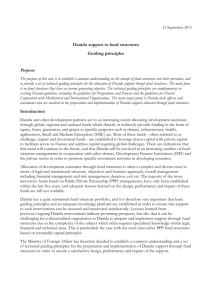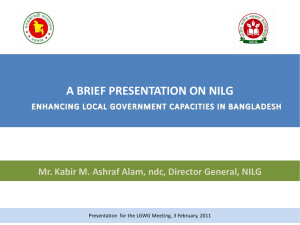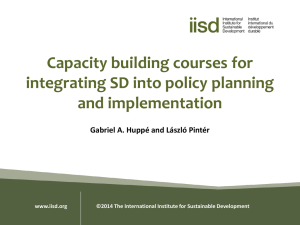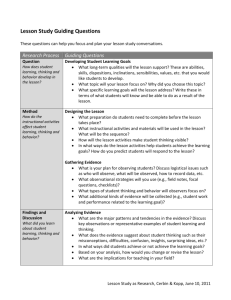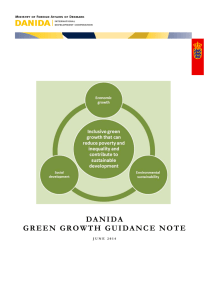word - Aid Management Guidelines
advertisement
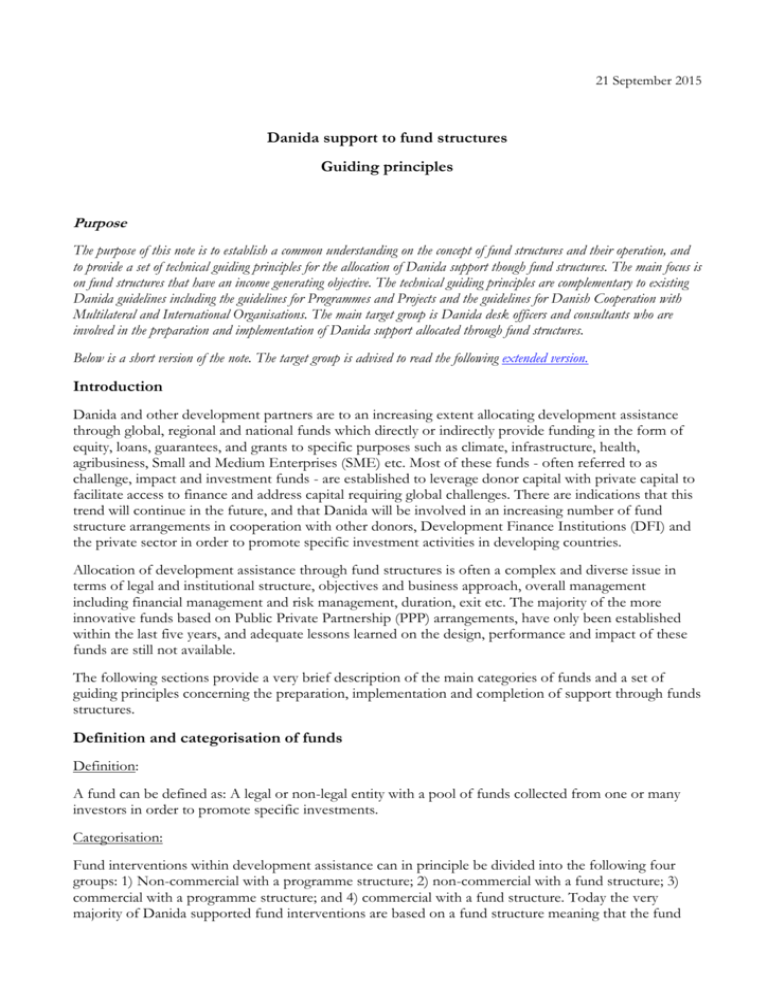
21 September 2015 Danida support to fund structures Guiding principles Purpose The purpose of this note is to establish a common understanding on the concept of fund structures and their operation, and to provide a set of technical guiding principles for the allocation of Danida support though fund structures. The main focus is on fund structures that have an income generating objective. The technical guiding principles are complementary to existing Danida guidelines including the guidelines for Programmes and Projects and the guidelines for Danish Cooperation with Multilateral and International Organisations. The main target group is Danida desk officers and consultants who are involved in the preparation and implementation of Danida support allocated through fund structures. Below is a short version of the note. The target group is advised to read the following extended version. Introduction Danida and other development partners are to an increasing extent allocating development assistance through global, regional and national funds which directly or indirectly provide funding in the form of equity, loans, guarantees, and grants to specific purposes such as climate, infrastructure, health, agribusiness, Small and Medium Enterprises (SME) etc. Most of these funds - often referred to as challenge, impact and investment funds - are established to leverage donor capital with private capital to facilitate access to finance and address capital requiring global challenges. There are indications that this trend will continue in the future, and that Danida will be involved in an increasing number of fund structure arrangements in cooperation with other donors, Development Finance Institutions (DFI) and the private sector in order to promote specific investment activities in developing countries. Allocation of development assistance through fund structures is often a complex and diverse issue in terms of legal and institutional structure, objectives and business approach, overall management including financial management and risk management, duration, exit etc. The majority of the more innovative funds based on Public Private Partnership (PPP) arrangements, have only been established within the last five years, and adequate lessons learned on the design, performance and impact of these funds are still not available. The following sections provide a very brief description of the main categories of funds and a set of guiding principles concerning the preparation, implementation and completion of support through funds structures. Definition and categorisation of funds Definition: A fund can be defined as: A legal or non-legal entity with a pool of funds collected from one or many investors in order to promote specific investments. Categorisation: Fund interventions within development assistance can in principle be divided into the following four groups: 1) Non-commercial with a programme structure; 2) non-commercial with a fund structure; 3) commercial with a programme structure; and 4) commercial with a fund structure. Today the very majority of Danida supported fund interventions are based on a fund structure meaning that the fund has its own legal structure with own management or a contracted fund manager, and this guidance note is consequently focusing on the fund structure categories (category 2 and 4 in the below matrix). With regards to objectives and development orientation Danida supported fund structures could also be categorised into the following four main groups of which this guidance note mainly concerns group 2 - 4: 1. Traditional facilities and challenge funds: This group comprises a large mix of non-profit facilities and challenge funds with strong development objectives. An example could be an advocacy facility, which Danida supports in a number of countries or the Skills Development Fund in Ghana; 2. Investment oriented challenge or revolving funds: Typically non-profit funds with strong development objectives but also some income generating objectives in order to achieve a certain level of sustainability of the fund, e.g. operational sustainability. An example could be the PASS trust (guarantee fund) in Tanzania or the aBi Trust (grants, loans and guarantees) in Uganda; 3. Traditional impact funds: Funds that have balanced development and profitability objectives in order to achieve a positive but low financial return. The funds are typically financed by donors, DFIs and philanthropic investors. An example could be the African Guarantee Fund registered in Mauritius and operated from Kenya; 4. Commercial impact or investment funds: Funds with strong profitability objectives within a framework of agreed development objectives. The funds are typically financed by donors, DFIs and private investors (mainly institutional). An example could be the Danish Climate Investment Fund managed by IFU, or the Global Climate Partnership Fund registered in Luxembourg and operated by an external recruited fund manager. For further information concerning fund structure overview and mapping see here. Guiding principles The below mentioned 15 guiding principles comprise some of the main issues that should be addressed during the preparation, implementation and exit of the fund structure interventions. All the below issues need to be addressed at an early stage of the preparation as they to a large extent become part of a fairly irreversible legal and institutional framework that has to be agreed upon before the start of the implementation. 1. The responsible units should always consult head-office expertise (GRV and TAS) at a very early stage of the preparation. During implementation GRV and TAS should be consulted when specific issues need to be addressed; 2. Planned new commitments to fund structures should be presented to the Danida Programme Committee; 3. Support should preferably be allocated through an existing fund structure; 4. Ensure that the responsible Danida representative/office has the required capacity to engage with the fund intervention on a long-term perspective; 5. Ensure that all basic statutory documents, agreements and operational guidelines, governance implications, budgets etc. are carefully assessed and understood before approval and signing of cooperation agreements; 6. Clarify whether Danida should only be a fund facilitator providing grants for TA, capacity building etc. and/or be a direct capital investor in the fund; 7. Ensure that the defined balance between the development and the commercial objectives, and the related strategic implementation approaches, are well understood and agreed upon by the involved parties at an early stage of the preparation process; 8. An overall exit strategy should be defined during preparation and regularly reassessed during implementation; 9. Assess carefully the legal, managerial and financial issues of the fund manager contract including tasks and responsibilities, fee structure, performance criteria etc.; 10. Ensure that clear leverage and additionality targets are defined and can be measured; 11. Ensure that the mix of financial products support the overall objectives and strategies of the fund; 12. Ensure that the risk sharing and the profit distribution procedures of the fund have been carefully assessed and agreed upon; 13. Ensure that the defined M&E and reporting requirements are realistic and well adapted to the objectives of the fund, the defined responsibilities of the fund manager, and the expectations of the private investors; 14. Ensure that Danida directly or indirectly becomes an active player in the governance structure of the fund, at least during annual meetings; 15. Ensure that adequate donor harmonisation and coordination is established in relation to the interventions of the fund; Key issues to be addressed during preparation and implementation The below figure indicates some of the key issues that need to be assessed during the preparation and implementation process of the fund structure: Before Programme Committee General objectives and strategic approach, Theory of Change, additionality etc. Fund structure framework Capacity of key stakeholders Available essential documents Possible participation in governance structures Types of financial products Risk sharing and profit distribution procedures Donor coordination Duration and exit Before Cooperation Agreement and start-up All basic statutory documents, agreements, operational guidelines Defined balance between development and commercial objectives and strategic approach Participation in governance structure Indicators, incl. leverage and additionality, and M&E system Fund manager contract incl. tender Modalities of financial products and services provided Exit strategy Implementation Exit Assessment of progress and performance reports Participation in governance meetings Major strategic and operational issues Possible reassessment of fund manager contract Possible reassessment of exit strategy Donor coordination Exit procedures and transfer of remaining funds/proceeds Reporting on completion, lessons learned and impact
